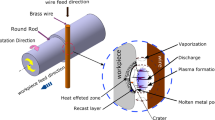Abstract
The purpose of this article is to address the applications of an operating window with a Taguchi-fuzzy logic design in conducting a reduced number of experiments to yield the optimal conditions and to develop robust melted bead properties of the electron beam (EB) process. The effects of parameters produced on a window on EB bead surface are studied, and dimensions of operating window using travel speed while adding different noise factors are identified. Using ANOVA, significant factors are identified and accounted for nearly 75% of the total variance. The defects can be reduced by widening an operating window. The experimental results show that, an extensive analysis of the quality of the results can be obtained with the successful optimization of functional characteristics. This new strategy allows one to design, simulate, and optimize a system, and accurately performs in a group of characteristics.
Similar content being viewed by others
References
Kenneth G (1988) Surface engineering for wear resistance. Prentice-Hall, Englewood Cliffs, NJ
Jenkins JB (1981) Some factors that influence electron beam hardening. J Heat Treat 2:28–32
Zenker R, Muller M, Murawski M (1991) Electron beam hardening. Heat Treat Met 18(3):79–88
Iwata A (1984) Transformations hardening by electron beam. Bull Jpn Soc Precis Eng 18:219–224
Jeffus L (1999) Welding: principles and applications, 4th edn. Thomson, Albany, NY
Chakrabarti AK (1982) A metallographic study of transformation in remelted ductile iron. Indian Metals 35:391–395
Kuehl RO (2000) Design of experiments: statistical principles of research design and analysis. Brooks/Cole, Belmont, CA
Yuin W, Alan W (2000) Taguchi methods for robust design. ASME, USA
Vijaya M, Krishna R, Prabhakar O, Shankar NG (1996) Simultaneous optimization of flame spraying process parameters for high quality molybdenum coatings using Taguchi methods. Surf Coat Technol 79:276–288
Alsaran A, Celik A, Celik C (2002) Determination of the optimum conditions for ion nitriding of AISI 5140 steel. Surf Coat Technol 160:219–226
Yang LJ (2001) Plasma surface hardening of ASSAB 760 steel specimens with Taguchi optimization of the processing parameters. J Mater Process Technol 113:521–526
Tarng YS, Yang WH, Juang SC (1999) The use of fuzzy logic in the Taguchi method for the optimization of the submerged arc welding process. Int J Adv Manuf Technol 16:668–674
Ross TJ (1995) Fuzzy logic with engineering applications, McGraw-Hill Inc
Author information
Authors and Affiliations
Corresponding author
Rights and permissions
About this article
Cite this article
Jean, MD., Lin, BT. & Chou, JH. The development of adaptive modified appearance using operating window methods for optimizing electron beam. Int J Adv Manuf Technol 35, 480–492 (2007). https://doi.org/10.1007/s00170-006-0724-y
Received:
Accepted:
Published:
Issue Date:
DOI: https://doi.org/10.1007/s00170-006-0724-y



